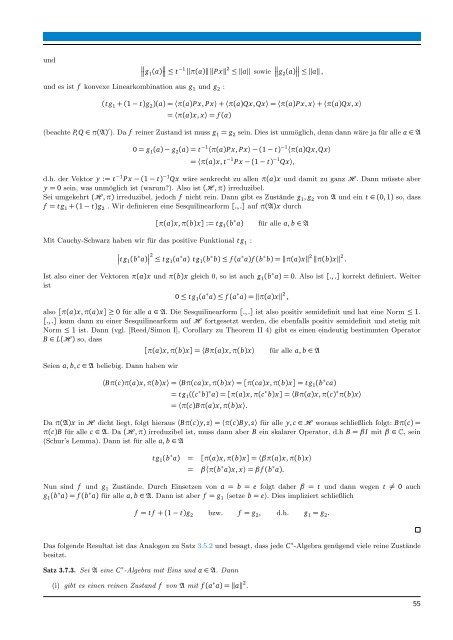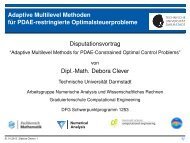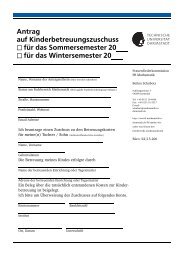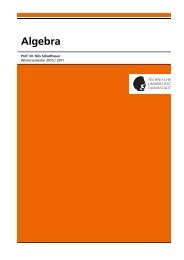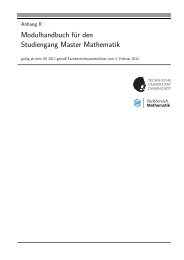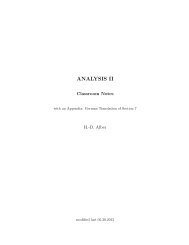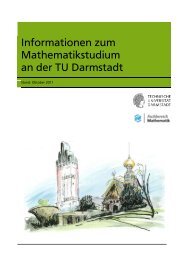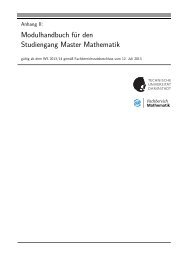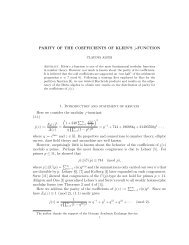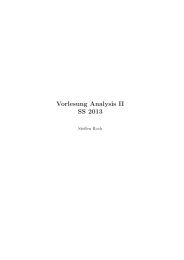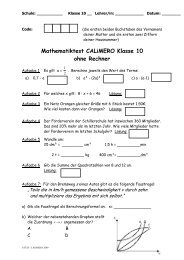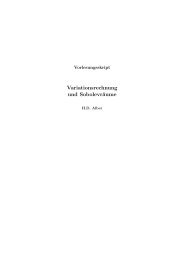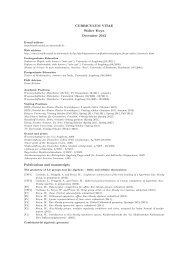Banach- und C -Algebren - Fachbereich Mathematik - Technische ...
Banach- und C -Algebren - Fachbereich Mathematik - Technische ...
Banach- und C -Algebren - Fachbereich Mathematik - Technische ...
Erfolgreiche ePaper selbst erstellen
Machen Sie aus Ihren PDF Publikationen ein blätterbares Flipbook mit unserer einzigartigen Google optimierten e-Paper Software.
<strong>und</strong> g1 (a) ≤ t −1 ‖π(a)‖ ‖P x‖ 2 ≤ ‖a‖ sowie g2 (a) ≤ ‖a‖ ,<strong>und</strong> es ist f konvexe Linearkombination aus g 1 <strong>und</strong> g 2 :(t g 1 + (1 − t)g 2 )(a) = 〈π(a)P x, P x〉 + 〈π(a)Qx,Qx〉 = 〈π(a)P x, x〉 + 〈π(a)Qx, x〉= 〈π(a)x, x〉 = f (a)(beachte P,Q ∈ π(A) ′ ). Da f reiner Zustand ist muss g 1 = g 2 sein. Dies ist unmöglich, denn dann wäre ja für alle a ∈ A0 = g 1 (a) − g 2 (a) = t −1 〈π(a)P x, P x〉 − (1 − t) −1 〈π(a)Qx,Qx〉= 〈π(a)x, t −1 P x − (1 − t) −1 Qx〉,d.h. der Vektor y := t −1 P x − (1 − t) −1 Qx wäre senkrecht zu allen π(a)x <strong>und</strong> damit zu ganz . Dann müsste abery = 0 sein, was unmöglich ist (warum?). Also ist ( , π) irreduzibel.Sei umgekehrt ( , π) irreduzibel, jedoch f nicht rein. Dann gibt es Zustände g 1 , g 2 von A <strong>und</strong> ein t ∈ (0, 1) so, dassf = t g 1 + (1 − t)g 2 . Wir definieren eine Sesquilinearform [., .] auf π(A)x durch[π(a)x, π(b)x] := t g 1 (b ∗ a)für alle a, b ∈ AMit Cauchy-Schwarz haben wir für das positive Funktional t g 1 : t g1 (b ∗ a) 2 ≤ t g 1 (a ∗ a) t g 1 (b ∗ b) ≤ f (a ∗ a)f (b ∗ b) = ‖π(a)x‖ 2 ‖π(b)x‖ 2 .Ist also einer der Vektoren π(a)x <strong>und</strong> π(b)x gleich 0, so ist auch g 1 (b ∗ a) = 0. Also ist [., .] korrekt definiert. Weiterist0 ≤ t g 1 (a ∗ a) ≤ f (a ∗ a) = ‖π(a)x‖ 2 ,also [π(a)x, π(a)x] ≥ 0 für alle a ∈ A. Die Sesquilinearform [., .] ist also positiv semidefinit <strong>und</strong> hat eine Norm ≤ 1.[., .] kann dann zu einer Sesquilinearform auf fortgesetzt werden, die ebenfalls positiv semidefinit <strong>und</strong> stetig mitNorm ≤ 1 ist. Dann (vgl. [Reed/Simon I], Corollary zu Theorem II 4) gibt es einen eindeutig bestimmten OperatorB ∈ L( ) so, dassSeien a, b, c ∈ A beliebig. Dann haben wir[π(a)x, π(b)x] = 〈Bπ(a)x, π(b)x〉für alle a, b ∈ A〈Bπ(c)π(a)x, π(b)x〉 = 〈Bπ(ca)x, π(b)x〉 = [π(ca)x, π(b)x] = t g 1 (b ∗ ca)= t g 1 ((c ∗ b) ∗ a) = [π(a)x, π(c ∗ b)x] = 〈Bπ(a)x, π(c) ∗ π(b)x〉= 〈π(c)Bπ(a)x, π(b)x〉.Da π(A)x in dicht liegt, folgt hieraus 〈Bπ(c)y, z〉 = 〈π(c)B y, z〉 für alle y, c ∈ woraus schließlich folgt: Bπ(c) =π(c)B für alle c ∈ A. Da ( , π) irreduzibel ist, muss dann aber B ein skalarer Operator, d.h B = β I mit β ∈ , sein(Schur’s Lemma). Dann ist für alle a, b ∈ At g 1 (b ∗ a) = [π(a)x, π(b)x] = 〈βπ(a)x, π(b)x〉= β〈π(b ∗ a)x, x〉 = β f (b ∗ a).Nun sind f <strong>und</strong> g 1 Zustände. Durch Einsetzen von a = b = e folgt daher β = t <strong>und</strong> dann wegen t ≠ 0 auchg 1 (b ∗ a) = f (b ∗ a) für alle a, b ∈ A. Dann ist aber f = g 1 (setze b = e). Dies impliziert schließlichf = t f + (1 − t)g 2 bzw. f = g 2 , d.h. g 1 = g 2 .Das folgende Resultat ist das Analogon zu Satz 3.5.2 <strong>und</strong> besagt, dass jede C ∗ -Algebra genügend viele reine Zuständebesitzt.Satz 3.7.3. Sei A eine C ∗ -Algebra mit Eins <strong>und</strong> a ∈ A. Dann(i) gibt es einen reinen Zustand f von A mit f (a ∗ a) = ‖a‖ 2 .55


